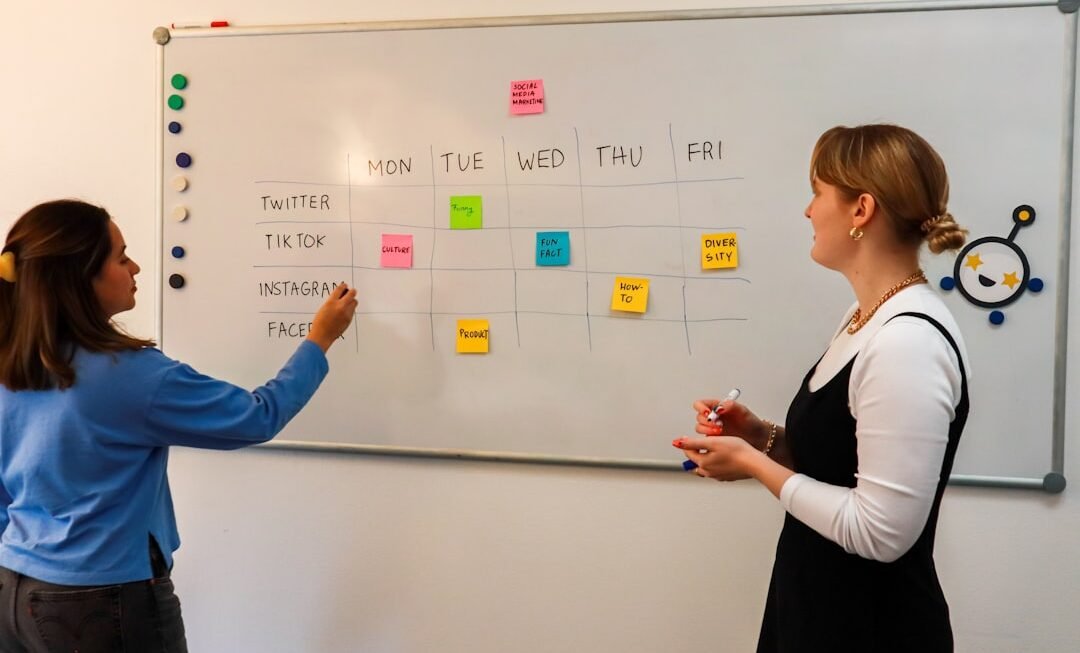The landscape of online education has undergone a significant transformation in recent years, driven by advancements in technology and a growing demand for personalized learning experiences. At the heart of this evolution lies the concept of smart content creation, which leverages data-driven insights and innovative tools to enhance the educational experience. Smart content creation refers to the development of educational materials that are not only engaging and interactive but also tailored to meet the diverse needs of learners.
This approach goes beyond traditional content creation methods, incorporating elements such as adaptive learning, multimedia integration, and real-time feedback mechanisms. As educational institutions and organizations increasingly embrace online learning, the importance of smart content creation becomes even more pronounced. It allows educators to create dynamic and responsive learning environments that cater to individual learning styles and preferences.
By harnessing the power of technology, educators can produce content that is not only informative but also immersive, fostering deeper engagement and understanding among students. This article delves into the evolution of online education, the principles of smart content creation, its benefits, and the tools that facilitate this innovative approach.
The Evolution of Online Education and Content Creation
The Early Days of Online Learning
In the early days of online learning, content was primarily delivered through static web pages or downloadable PDFs, which often lacked interactivity and engagement.
The Rise of Interactive Content
The introduction of Learning Management Systems (LMS) allowed for more structured course offerings, enabling educators to organize materials and track student progress more effectively. The rise of video-based learning marked a significant turning point in online education. Platforms like YouTube and educational websites began to incorporate video lectures, tutorials, and demonstrations, making learning more accessible and engaging.
What is Smart Content Creation and How Does it Differ from Traditional Methods?
Smart content creation encompasses a range of strategies and technologies designed to produce educational materials that are adaptive, personalized, and interactive. Unlike traditional methods that often rely on a one-size-fits-all approach, smart content creation focuses on tailoring educational experiences to meet the unique needs of individual learners. This involves using data analytics to understand learner behavior, preferences, and performance, allowing educators to create content that resonates with their audience.
One key distinction between smart content creation and traditional methods is the use of adaptive learning technologies. These technologies enable content to adjust in real-time based on a learner’s progress and understanding. For instance, if a student struggles with a particular concept, the system can provide additional resources or alternative explanations to help them grasp the material better.
In contrast, traditional methods typically present information in a linear fashion without considering individual learner needs. This adaptability not only enhances comprehension but also fosters a sense of agency among learners, empowering them to take control of their educational journey.
The Benefits of Smart Content Creation for Online Education
The advantages of smart content creation in online education are manifold. One of the most significant benefits is the ability to enhance learner engagement. By incorporating interactive elements such as quizzes, simulations, and multimedia resources, educators can create a more stimulating learning environment that captures students’ attention and encourages active participation.
Engaged learners are more likely to retain information and develop a deeper understanding of the subject matter. Another critical benefit is the personalization of learning experiences.
For example, visual learners may benefit from infographics and videos, while auditory learners might prefer podcasts or narrated presentations. This level of customization not only improves learner satisfaction but also leads to better academic outcomes. Furthermore, by utilizing analytics tools, educators can track student progress and identify areas where additional support may be needed, ensuring that no learner is left behind.
Tools and Technologies for Smart Content Creation
A variety of tools and technologies are available to facilitate smart content creation in online education. Learning Management Systems (LMS) such as Moodle, Canvas, and Blackboard provide educators with platforms to organize course materials, track student progress, and facilitate communication between instructors and learners. These systems often include features that support multimedia integration, allowing educators to embed videos, interactive quizzes, and discussion forums directly into their courses.
In addition to LMS platforms, there are numerous authoring tools designed specifically for creating interactive content. Tools like Articulate Storyline and Adobe Captivate enable educators to develop engaging e-learning modules that incorporate branching scenarios, simulations, and gamified elements. These tools empower educators to create rich learning experiences without requiring extensive programming knowledge.
Moreover, data analytics tools such as Google Analytics or specialized educational analytics platforms can provide insights into learner behavior and performance, helping educators refine their content strategies over time.
How Smart Content Creation is Revolutionizing the Learning Experience
Smart content creation is fundamentally changing how learners interact with educational materials. By prioritizing interactivity and personalization, it fosters a more engaging learning environment that encourages exploration and critical thinking. For instance, instead of passively consuming information through lectures or readings, students can actively participate in their learning through interactive simulations or collaborative projects.
This shift from passive to active learning not only enhances retention but also cultivates essential skills such as problem-solving and teamwork. Moreover, smart content creation promotes inclusivity by accommodating diverse learning needs. For example, students with disabilities can benefit from accessible content that includes features such as screen readers or captioned videos.
By designing materials with inclusivity in mind, educators can ensure that all learners have equal opportunities to succeed in their educational pursuits. This commitment to accessibility aligns with broader educational goals of equity and inclusion, making smart content creation an essential component of modern online education.
The Role of Artificial Intelligence in Smart Content Creation
Artificial intelligence (AI) plays a pivotal role in enhancing smart content creation by providing powerful tools for personalization and adaptability. AI algorithms can analyze vast amounts of data related to learner behavior, preferences, and performance metrics. This analysis enables educators to create tailored learning experiences that respond dynamically to individual needs.
For instance, AI-driven platforms can recommend specific resources or activities based on a student’s past performance or engagement levels. Additionally, AI can facilitate the development of intelligent tutoring systems that provide real-time feedback and support to learners. These systems can identify areas where students may be struggling and offer targeted interventions or additional resources to help them overcome challenges.
By automating aspects of content delivery and assessment, AI allows educators to focus more on facilitating meaningful interactions with their students rather than spending excessive time on administrative tasks.
Challenges and Limitations of Smart Content Creation in Online Education
Despite its numerous advantages, smart content creation is not without challenges. One significant limitation is the potential for over-reliance on technology. While data-driven insights can enhance personalization, there is a risk that educators may become too dependent on algorithms at the expense of human intuition and creativity.
Striking a balance between technology-driven approaches and traditional pedagogical methods is crucial for maintaining effective teaching practices. Another challenge lies in ensuring equitable access to technology among learners. Not all students have access to high-speed internet or advanced devices necessary for engaging with smart content effectively.
This digital divide can exacerbate existing inequalities in education, making it essential for institutions to address these disparities through targeted initiatives such as providing resources for underserved communities or offering offline alternatives for course materials.
Best Practices for Implementing Smart Content Creation in Online Education
To successfully implement smart content creation in online education, educators should consider several best practices. First and foremost is the importance of understanding the target audience. Conducting thorough needs assessments can help educators identify the specific challenges and preferences of their learners, allowing for more effective content design.
Engaging with students through surveys or focus groups can provide valuable insights into their learning experiences. Additionally, incorporating iterative design processes can enhance the quality of smart content. Educators should be open to feedback from students and willing to make adjustments based on their input.
Regularly updating course materials ensures that they remain relevant and aligned with current trends in both education and industry practices. Furthermore, fostering collaboration among educators can lead to the sharing of best practices and innovative ideas for creating engaging content.
Case Studies of Successful Smart Content Creation in Online Education
Numerous institutions have successfully implemented smart content creation strategies that have yielded positive results in online education. For example, Arizona State University (ASU) has embraced adaptive learning technologies within its online courses. By utilizing platforms like Smart Sparrow, ASU has been able to create personalized learning pathways for students based on their individual progress and understanding of course material.
This approach has led to improved retention rates and higher levels of student satisfaction. Another notable case is Coursera’s partnership with universities worldwide to offer massive open online courses (MOOCs). Through its platform, Coursera employs data analytics to track learner engagement and performance across various courses.
As a result, Coursera has been able to create high-quality educational experiences that cater to diverse audiences while maintaining rigorous academic standards.
The Future of Smart Content Creation in Online Education
Looking ahead, the future of smart content creation in online education appears promising as technology continues to advance at an unprecedented pace. Emerging trends such as virtual reality (VR) and augmented reality (AR) hold immense potential for creating immersive learning experiences that transcend traditional boundaries. These technologies can transport learners into simulated environments where they can practice skills or explore complex concepts in ways that were previously unimaginable.
Moreover, as AI continues to evolve, we can expect even greater levels of personalization in online education. Future platforms may leverage machine learning algorithms capable of predicting learner needs with remarkable accuracy based on historical data patterns. This level of sophistication could lead to hyper-personalized learning experiences tailored not just to individual preferences but also aligned with career aspirations or industry demands.
In conclusion, smart content creation represents a transformative approach within online education that prioritizes engagement, personalization, inclusivity, and adaptability through innovative technologies like AI while addressing challenges related to access equity among learners across diverse backgrounds.












